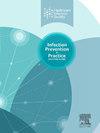Utilizing an adenosine triphosphate bioluminescence assay as an indicator of instrument and environmental cleanliness in the radiology department: a pilot study
IF 1.9
Q3 INFECTIOUS DISEASES
引用次数: 0
Abstract
Background
Controlling healthcare-associated infections (HAIs) remains one of the major challenges faced by healthcare systems worldwide. Effective management of HAIs has become a critical indicator for evaluating the quality of services provided by medical institutions.
Aim
This study aims to compare the outcomes of environmental and instrument cleaning audits using an adenosine triphosphate (ATP) bioluminescence assay to prevent the spread of micro-organisms within medical environments.
Methods
The ATP monitoring system employs a cold light instrument integrated with bioluminescence enzyme detection technology. One hundred and ninety-one points were evaluated in 2020, 158 points in 2021, and 146 points in 2022.
Findings
From 2020 to 2022, the rate of environmental cleaning compliance (<200 relative light units (RLU)) in the radiology department increased from 82% to 92%, while the rate of excellent cleanliness (<100 RLU) improved significantly from 58% to 86% (P<0.001). Our findings indicate that medical instruments and high-touch clinical instrument surfaces (HTCIS) in areas frequently contacted by patients are the primary contributors to the spread of pathogenic bacteria.
Conclusions
HTCIS should remain a focal point for improving environmental cleanliness and subsequent inspections in the radiology department. Enhancing the cleanliness of these surfaces is a vital strategy to prevent further nosocomial transmission.
利用三磷酸腺苷生物发光试验作为放射科仪器和环境清洁度的指标:一项试点研究
背景控制卫生保健相关感染(HAIs)仍然是全球卫生保健系统面临的主要挑战之一。卫生保健机构的有效管理已成为评价医疗机构服务质量的重要指标。目的本研究旨在比较使用三磷酸腺苷(ATP)生物发光法进行环境和仪器清洁审计的结果,以防止微生物在医疗环境中传播。方法ATP监测系统采用冷光仪结合生物发光酶检测技术。2020年为191分,2021年为158分,2022年为146分。结果从2020年到2022年,放射科环境清洁符合率(<;200相对光单位(RLU))从82%提高到92%,优异清洁率(<;100相对光单位)从58%显著提高到86% (P<0.001)。我们的研究结果表明,患者经常接触的医疗器械和高接触临床器械表面(HTCIS)是致病菌传播的主要因素。结论shtcis仍应是提高放射科环境清洁度和后续检查的重点。加强这些表面的清洁是防止进一步医院传播的重要策略。
本文章由计算机程序翻译,如有差异,请以英文原文为准。
求助全文
约1分钟内获得全文
求助全文
来源期刊

Infection Prevention in Practice
Medicine-Public Health, Environmental and Occupational Health
CiteScore
4.80
自引率
0.00%
发文量
58
审稿时长
61 days
 求助内容:
求助内容: 应助结果提醒方式:
应助结果提醒方式:


